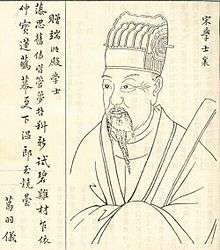The Record of Tea

The Record of Tea (Chinese: 茶录; pinyin: Chá Lù), also known as the "Tea Note" is a Chinese tea classic by Cai Xiang written in 1049–1053 CE.
Reputed as one of the greatest calligraphers of the Song dynasty, Cai Xiang was also a great tea connoisseur. During the Qingli (慶曆) era of the Renzong Emperor (1041–1048), Cai Xiang was the Officer of Transportation in Fujian. He pioneered the manufacture of a small "Dragon Tribute Tea Cake" (大小龙团 daxiao longtuan) of superlative quality.
He wrote the first tea treatise of the Song dynasty, "The Record of Tea". In this book, he documents, explains in detail, comments and also criticizes the preparation and usage of tea and its vessels. He also made one of the first documented comments on Jian ware. The work consists of two volumes.
He was a native of Fujian; he was the first writer to report the tea spotting game of Jian'an (now Shuiji county in Fujian).
Table of contents
- Part I: About Tea
- Properties of Tea
- On Storage
- On Baking
- On Pressing
- On Sieving
- On Boiling Water
- On Preheating
- On Tea Spotting
- Part II: Tea Utensils
- Tea Warmer
- Tea Canister
- Tea Hammer
- Tea Clamps
- Tea Grinder
- Tea Sieve
- Tea Vessel
- Tea Spoon
- Tea Kettle
Quotes

| “ | Tea has intrinsic aroma. But tribute tea manufacturers like to mix small amount of Dryobalanops aromatica camphor, supposedly to enhance the aroma. The local people of Jian'an never mix any incense into tea, afraid to robe the natural aroma of tea. | ” |
| “ | Tea is of light colour and looks best in black cups. The cups made at Jianyang are bluish-black in colour, marked like the fur of a hare. Being of rather thick fabric they retain the heat, so that when once warmed through they cool very slowly, and they are additionally valued on this account. None of the cups produced at other places can rival these. Blue and white cups are not used by those who give tea-tasting parties.[2] | ” |
See also
- "Treatise on Tea" by the Huizong Emperor, written in 1107 CE
- "Pictorial of Tea Ware" by Shenan, written in 1269 CE
References
- ↑ "Tea Bowl with "Hare's-Fur" Glaze". Metropolitan Museum of Art. 2012-11-30. Retrieved 2013-02-19.
- ↑ Bushell, Stephen W. (1910). "10. Specimens of the Sung Dynasty". Description of Chinese pottery and porcelain; being a translation of the T'ao shuo. Oxford: University of Oxford. pp. 123–124.